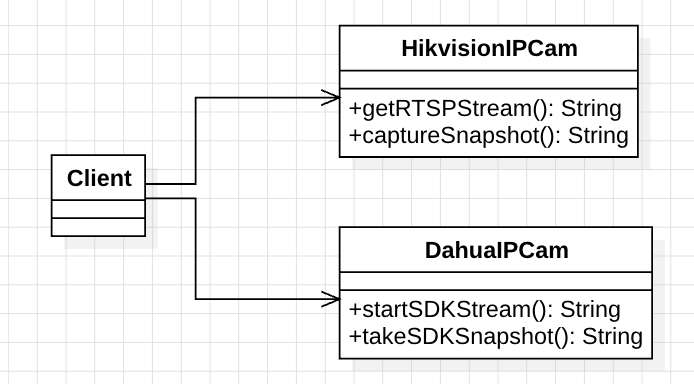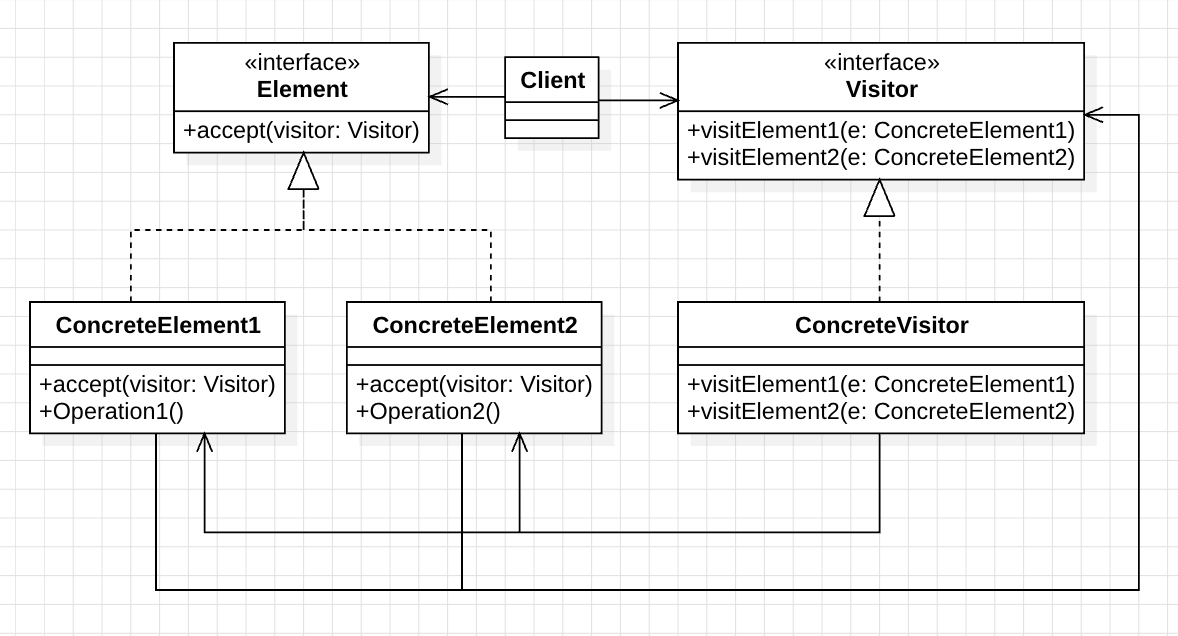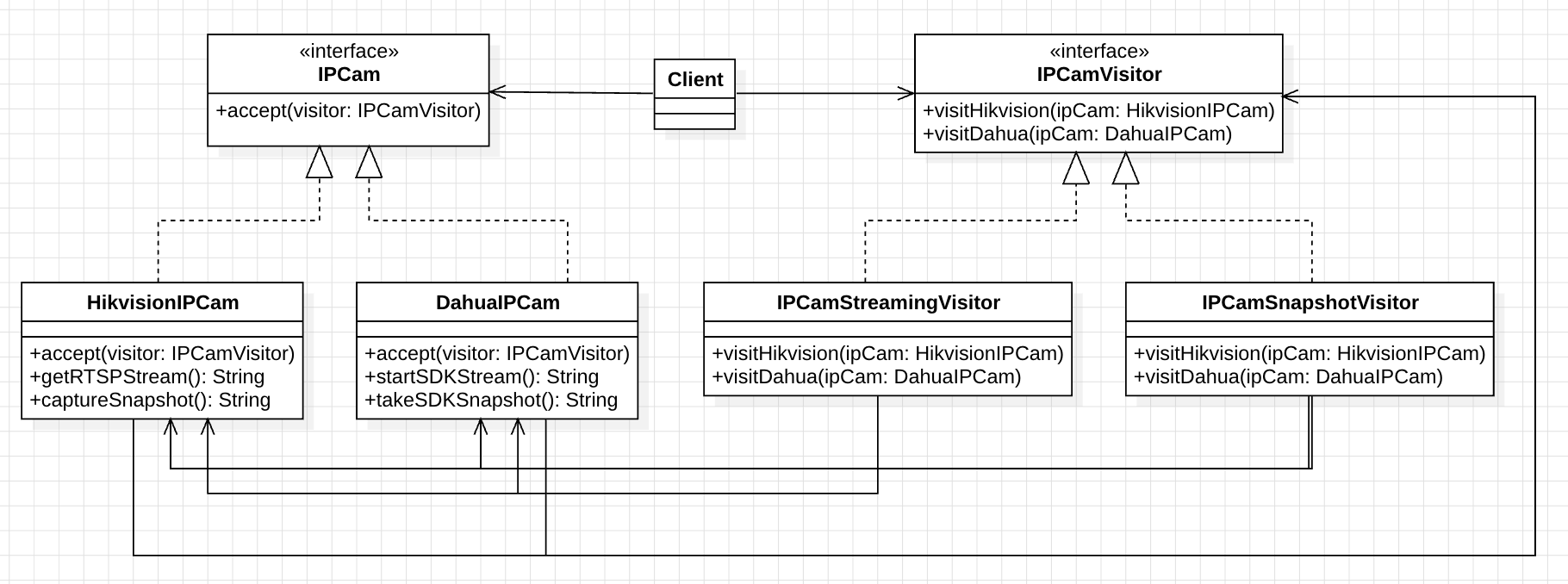Design Pattern 27: Visitor Pattern - Complete Guide with Real-World IoT Examples
📁 Download the complete Design Pattern series code from our design_pattern repository.
🎯 What is the Visitor Pattern?
The Visitor Pattern is a behavioral design pattern that lets you add new operations to existing object structures without modifying their classes. It separates algorithms from the objects on which they operate, making it easy to extend and maintain complex systems.
Key Benefits:
- ✅ Open/Closed Principle - Add new operations without changing object structure
- ✅ Centralized logic - Keep related operations together
- ✅ Extensibility - Easily support new operations and object types
- ✅ Maintainability - Clean separation of concerns
- ✅ Scalability - Ideal for large, evolving systems
🚀 Real-World Problem: IoT App Integrating Multiple IPCam Brands
Suppose you are building an IoT app that needs to support multiple IPCam brands, each with different streaming and snapshot APIs:
System Requirements:
- Support for multiple IPCam brands (e.g., HIKVISION, DAHUA)
- Each brand provides different streaming and snapshot methods
- App code should not depend on brand-specific details
- Easy to add new brands in the future
- Avoid modifying core IPCam structure (often vendor-provided)
Business Rules:
- All IPCam operations (streaming, snapshot) must be extensible
- New operations should not require changes to existing IPCam classes
- Maintain clean, maintainable codebase
🏗️ Object-Oriented Analysis (OOA)
Let’s analyze the problem and identify the core components:

Identified Forces:
- Difficult to extend for new brands
- Violation of Open/Closed Principle (OCP)
- Inconsistent handling of brand-specific operations
💡 Visitor Pattern Solution
After analyzing the forces, we can apply the Visitor Pattern to decouple operations from object structure:

Visitor Pattern Components:
- Visitor Interface - Defines operations for each object type
- Concrete Visitors - Implement specific operations (e.g., streaming, snapshot)
- Element Interface - Defines
accept(visitor)method - Concrete Elements - Implement
acceptand brand-specific logic
Benefits:
- Add new operations easily (just add a new visitor)
- Centralize operation logic
- Keep object structure stable
🛠️ Implementation: IPCam Integration Example

1. Element Interface
interface IPCam {
fun accept(visitor: IPCamVisitor)
}
2. Concrete Elements
class HikvisionIPCam : IPCam {
override fun accept(visitor: IPCamVisitor) {
visitor.visitHikvision(this)
}
fun getRTSPStream(): String = "rtsp://hikvision/stream"
fun captureSnapshot(): String = "Hikvision Snapshot"
}
class DahuaIPCam : IPCam {
override fun accept(visitor: IPCamVisitor) {
visitor.visitDahua(this)
}
fun startSDKStream(): String = "Dahua SDK Stream"
fun takeSDKSnapshot(): String = "Dahua Snapshot"
}
3. Visitor Interface
interface IPCamVisitor {
fun visitHikvision(ipCam: HikvisionIPCam)
fun visitDahua(ipCam: DahuaIPCam)
}
4. Concrete Visitors
class IPCamStreamingVisitor : IPCamVisitor {
override fun visitHikvision(ipCam: HikvisionIPCam) {
println("Streaming: ${ipCam.getRTSPStream()}")
}
override fun visitDahua(ipCam: DahuaIPCam) {
println("Streaming: ${ipCam.startSDKStream()}")
}
}
class IPCamSnapshotVisitor : IPCamVisitor {
override fun visitHikvision(ipCam: HikvisionIPCam) {
println("Snapshot: ${ipCam.captureSnapshot()}")
}
override fun visitDahua(ipCam: DahuaIPCam) {
println("Snapshot: ${ipCam.takeSDKSnapshot()}")
}
}
5. Client Code
fun main() {
val ipCams: List<IPCam> = listOf(HikvisionIPCam(), DahuaIPCam())
val streamingVisitor = IPCamStreamingVisitor()
val snapshotVisitor = IPCamSnapshotVisitor()
for (ipCam in ipCams) {
ipCam.accept(streamingVisitor)
ipCam.accept(snapshotVisitor)
}
}
Expected Output:
Streaming: rtsp://hikvision/stream
Snapshot: Hikvision Snapshot
Streaming: Dahua SDK Stream
Snapshot: Dahua Snapshot
📊 Visitor Pattern vs Alternative Approaches
| Approach | Pros | Cons |
|---|---|---|
| Visitor Pattern | ✅ Add new operations easily ✅ Centralized logic | ❌ Must update visitor for new element types ❌ Double dispatch complexity |
| Strategy Pattern | ✅ Runtime flexibility ✅ No double dispatch | ❌ No access to element internals ❌ Harder to add new operations |
| Direct Inheritance | ✅ Simple for small systems | ❌ Tight coupling ❌ Hard to extend |
🎯 When to Use the Visitor Pattern
✅ Perfect For:
- Complex object structures (ASTs, document models)
- IoT device integration (multi-brand support)
- Compilers and interpreters (expression evaluation)
- UI component trees (rendering, event handling)
- Code analysis tools (linting, refactoring)
❌ Avoid When:
- Element types change frequently (must update all visitors)
- Simple, flat object structures
- Performance-critical code (double dispatch overhead)
🔧 Advanced Visitor Pattern Implementations
1. Adding New Operations
class IPCamFirmwareUpgradeVisitor : IPCamVisitor {
override fun visitHikvision(ipCam: HikvisionIPCam) {
println("Upgrading firmware for Hikvision")
}
override fun visitDahua(ipCam: DahuaIPCam) {
println("Upgrading firmware for Dahua")
}
}
2. Adding New IPCam Brands
class EzvizIPCam : IPCam {
override fun accept(visitor: IPCamVisitor) {
// Add visitEzviz to IPCamVisitor and all concrete visitors
// visitor.visitEzviz(this)
}
fun getEzvizStream(): String = "Ezviz Stream"
fun captureEzvizSnapshot(): String = "Ezviz Snapshot"
}
📈 Real-World Applications
1. IoT Device Management
- Multi-brand camera integration
- Unified device operations (streaming, snapshot, firmware upgrade)
2. Compilers and Interpreters
- Abstract Syntax Tree (AST) traversal
- Code generation, optimization, and analysis
3. UI Component Trees
- Rendering, event handling, and layout
4. Code Analysis Tools
- Linting, static analysis, refactoring
🚨 Common Pitfalls and Best Practices
1. Double Dispatch Complexity
- Visitor pattern uses double dispatch; keep visitor interfaces up to date
2. Element Explosion
- Too many element types can make visitor maintenance harder
3. Best Practices
- Use clear naming for visitor methods (e.g.,
visitHikvision) - Document all supported element types in visitor interface
- Use abstract base classes for shared logic
🔗 Related Articles
- Design Pattern 1: Object-Oriented Concepts
- Design Pattern 2: Design Principles
- Template Method Pattern
- Strategy Pattern
- Command Pattern
✅ Conclusion
Through the Visitor Pattern, we successfully decoupled IPCam operations from their structure, enabling easy extension and centralized logic management.
Key Advantages:
- 🎯 Open/Closed Principle - Add new operations without changing object structure
- 🔧 Centralized logic - Keep related operations together
- 📈 Easy extension - Add new operations or brands with minimal changes
- 🛡️ Maintainability - Clean separation of concerns
- ⚡ Scalability - Ideal for large, evolving systems
Design Principles Followed:
- Single Responsibility Principle (SRP): Separate operation logic from object structure
- Open-Closed Principle (OCP): Open for extension, closed for modification
- Don’t Repeat Yourself (DRY): Centralize operation logic
Perfect For:
- IoT device integration (multi-brand support)
- AST traversal (compilers, interpreters)
- UI frameworks (component trees)
- Code analysis tools (linting, refactoring)
The Visitor Pattern provides an elegant solution for adding new operations to complex object structures while maintaining a clean, extensible codebase!
💡 Pro Tip: Use the Visitor Pattern when you need to add many unrelated operations to object structures, but avoid it if your element types change frequently.
🔔 Stay Updated: Follow our Design Pattern series for more software architecture insights!
Enjoy Reading This Article?
Here are some more articles you might like to read next: